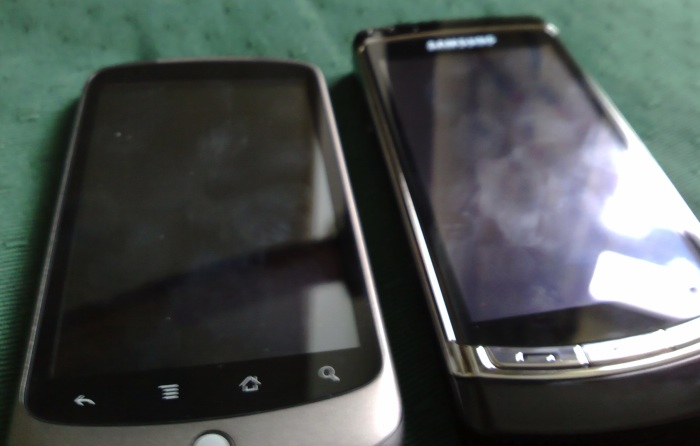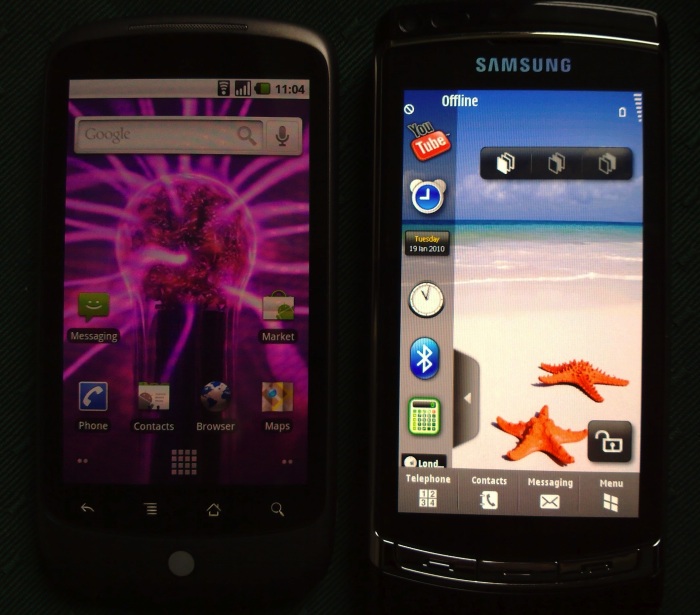
Nexus One on the left, obviously. Note the differences in default OLED screen brightness. Both devices have 'Auto-brightness' turned on, i.e. the light sensor is intelligently managing brightness in order to conserve battery life. The Nexus One's setting is tuned down quite a bit, I'm guessing the Google engineers were a bit worried about power. See below for a brighter side by side shot...
The Nexus One, by the way, was imported into the UK by Tim Salmon (of AAS and The Phones Show Chat), but an official UK release isn't far off, or so we're told. Importers have to pay VAT and other duties, so it's currently an expensive way to get hold of the device.
The similarities to the hardware of the Samsung i8910 HD are so marked (size, display area, display tech, processor, graphics acceleration, etc) that I simply couldn't resist pitching the two 'super-phones' against each other. As usual, where there's a clear 'winner' (objectively), I've shaded the cell green....
| Samsung i8910 HD 8GB | Google Nexus One | |
| Cost (SIM-free) | Around £400 | Around £400 (imported into the UK), cheaper in the USA! |
| Form factor | Monoblock plastic tablet, but very strong, 13mm thick, 148g | Monoblock tablet, metal and plastic, quite strong, is slightly shorter and thinner, at 11.5mm, though it feels a lot thinner, due to rounded edges and corners, 130g |
| Operating system, interface and support | Symbian OS 9.4, S60 5th Edition, optional Touchwiz widgets on homescreen, updatable via Samsung PC Studio, future somewhat uncertain | Android 2.1, updatable over the air from Google, sure to get future updates in quantity, already includes voice entry of text in all fields, giving more options |
| Display | 3.7" AMOLED, capacitive touch, 640 by 360 pixels | 3.7" AMOLED, capacitive touch, 800 by 480 pixels |
| Processor(s) | ARM Cortex A8 600MHz, PowerVR SGX graphics - it's fast | Qualcomm Snapdragon 3G QSD8250, 1GHz - also fast! |
| Memory | 40MB free flash memory on disk C:, 8GB mass memory (16GB version also available), microSD expansion, apps can be installed on any disk, 150MB free RAM | Approx 200MB user memory (for apps, internal data, working space etc), plus microSD expansion for media, around 250MB free RAM (exact amounts to be tested once I've had longer with the device!) |
| Camera/camcorder | 8 megapixel stills with decent lens and single LED flash, 720p (HD) video recording, but not quite as impressive as this sounds. 720 by 480 resolution video works better in terms of quality and frame rate | 5 megapixels stills with 'HTC-class' lens and sensor (that's not exactly a compliment), single LED flash, 720 by 480 resolution video recording at 20fps 'or higher' |
| Application highlights | Quickoffice viewers, Google Mail client, Smart reader (business cards), Dictionary, Zip manager, Converter, RoadSync (MS Exchange) | Facebook client, native Google Mail client, excellent little Weather/News utility, YouTube client, Google Talk client |
| Web browsing | S60 Web (webkit-based), functional without ever really impressing, though there is Flash support if needed. Touch interface is klunky | Browser is also Webkit-based, but with no Flash support (this is 'coming soon'). Page zooming is handled better though, and speed is generally good. |
| Maps and navigation | A version of Route 66 is loaded on the mass memory and is (in theory) available online, but it's easy to lose the app and not find a legal replacement download. The GPS+ Assisted system works well and the GPS receiver itself is sensitive. Best used with Google Maps? | Google Maps is comprehensive but relies on a connection and doesn't yet have real time navigation in any market other than the USA. Wi-Fi positioning built-in, in addition to a good GPS receiver. With the addition of additional Navigation countries in 2010 and 2011, has the potential to be excellent provided you can get a cellular signal |
| Media playback | Media browser/player includes DivX and H.264 support, most videos in most formats (including WMV, FLV) are fully playable | Gallery plays MP4, including H.264, but no support for DivX, WMV or Flash videos |
| Battery/power | 1500mAh, microUSB charging, two days with careful use | 1400mAh, microUSB charging, nightly charging needed |
| Connectivity | microUSB, Bluetooth, Wi-Fi, quad band GSM, tri-band 3G | microUSB, Bluetooth, Wi-Fi, quad band GSM, dual band 3G |
| Audio |
3.5mm audio/TV out, plus very loud stereo speakers, MP3, eAAC, WMA compatibility |
3.5mm audio out, average mono speaker, badly positioned on back, MP3, eAAC compatibility |
| App ecosystem | S60 5th Edition software is available, though apps which are full compatible number in the low hundreds (there being no Nokia certificates in the device, which has some compatibility implications) | Android Market is growing well, the choice already exceeds that in the Symbian ecosystem and apps aren't burdened by supporting legacy devices |
| Current stability | Average, awaiting a major firmware update to add extra functionality | Good, but with one or two major issues that need fixing |
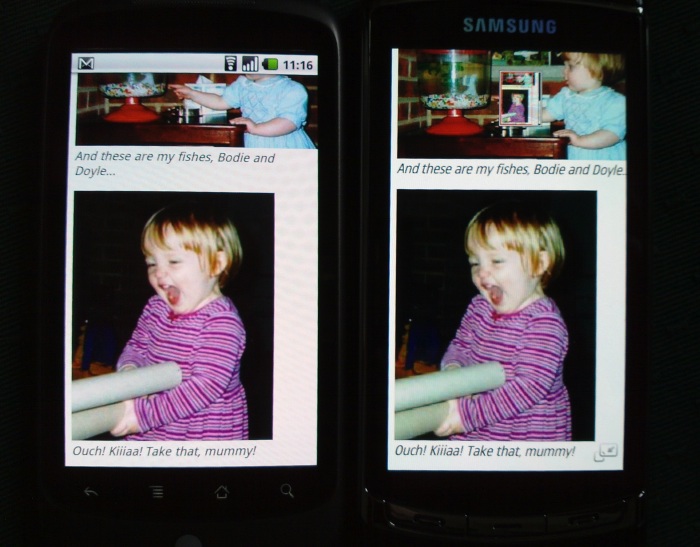
With Auto-brightness disabled and each OLED screen turned up to maximum. I'd say the Nexus One's screen is marginally more vibrant, but they're both excellent.
Honours even then, for these two 3.7" OLED super-phones? I'd say so. The Samsung i8910 HD has to win on raw specifications, but the Google Nexus One isn't a million miles behind and has the advantage of better, and more current, software support from one of the biggest companies in the tech world.
Were there any disappointments for me, an experienced Symbian user coming to the very latest Android flagship? Undoubtedly yes:
- The OS itself seemed only 90% complete, with omissions such as a file manager, Flash support, poor video compatibility, no real time navigation outside the USA, and so on. There's a general reliance on third party applications to fill the gaps, but I'd like to see more in the main OS.
- The Nexus One is made by HTC - while they do a competent job, some of the components they use leave a lot to be desired when compared to their equivalents in the Samsung i8910 HD. Look at the camera quality, the speaker quality, even the touchscreen didn't seem as sensitive and was badly aligned (though this last can probably be fixed in software)
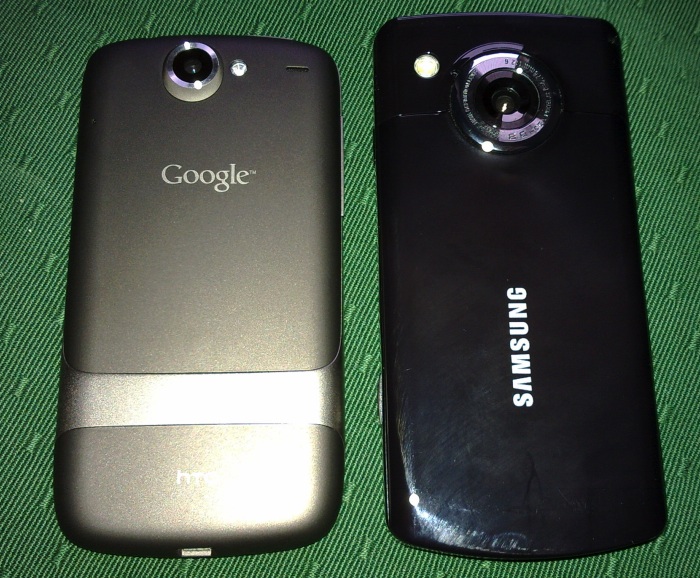
Having said that, the feel in the hand of the Nexus One is far superior to that of the i8910 HD and I'm convinced by it as a 'product' - it's not something that will have normal users recoiling in horror, even though the screen size is identical and the battery comparable. In this regard, Google have nailed it with the Nexus One.
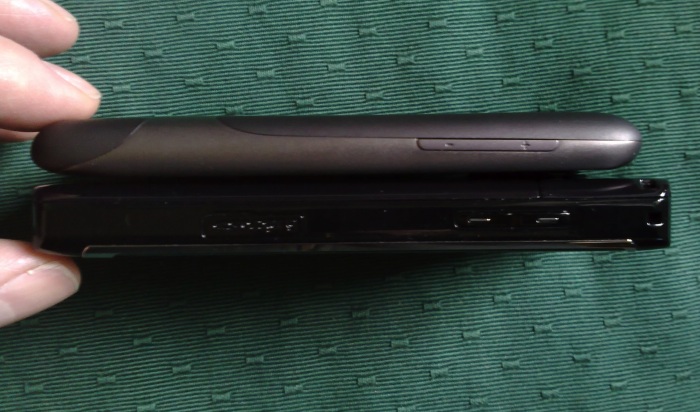
For a detailed review of the Google Nexus One, keep your eyes on my Phones Show video podcast.... 8-)
Steve Litchfield, All About Symbian, 19 Jan 2010
PS. See the following photo to illustrate the huge downside of these touchscreens - here are the two devices after only 10 minutes prodding and swiping. Urgh!
